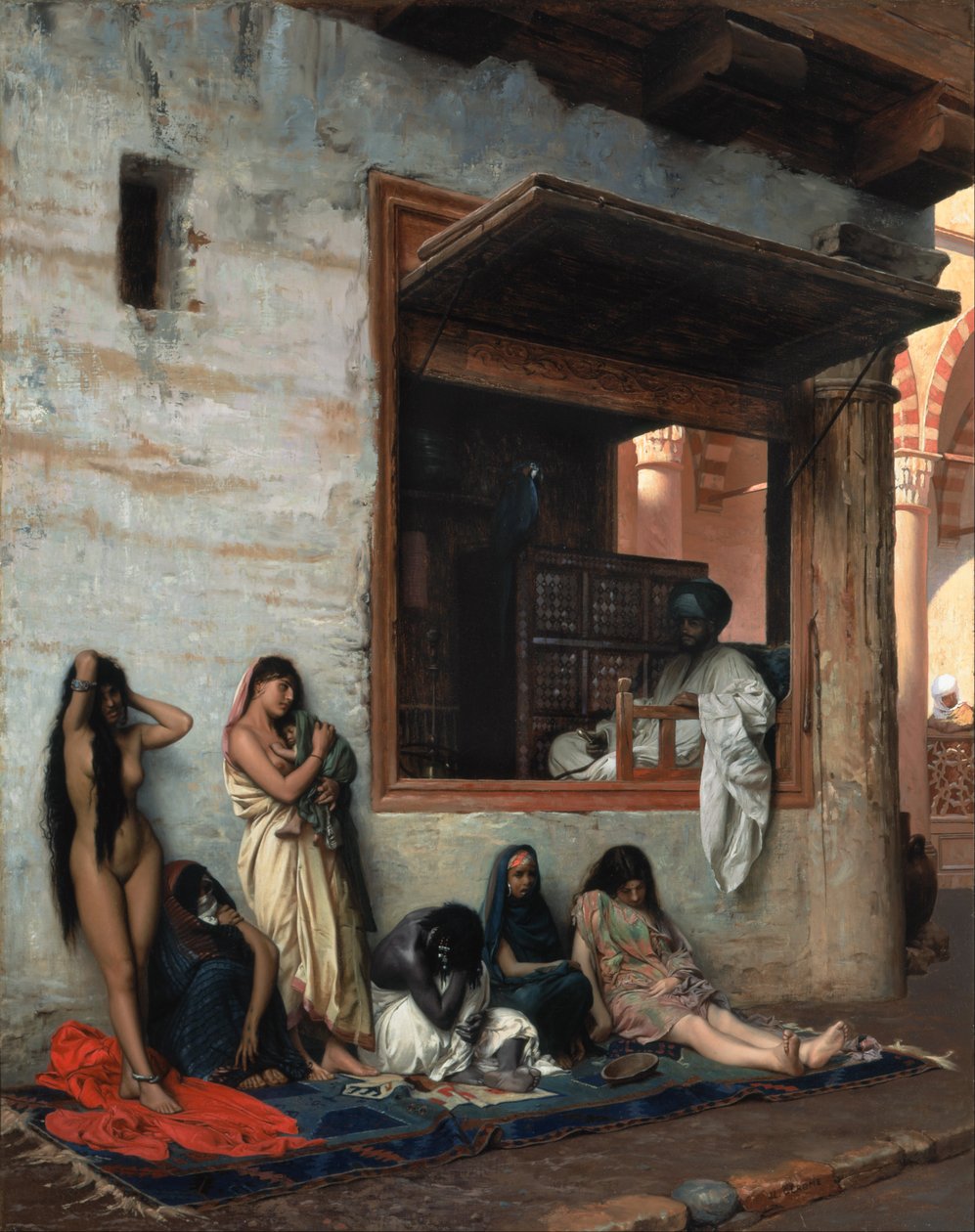1871 · Picture ID: 14635
Realism
· Female Nude · Our favourites
The painting "The Slave Market" is a painting from 1866 by the French painter Jean-Léon Gérôme, currently exhibited at the Cincinnati Art Museum. The realism to be assigned market scene shows a slave trader, including offered goods in the quiet corner of a marketplace. The everyday objectivity of the pictorial expression follows the artistic tradition of real illustrations, with a coat of hidden political connotation. What can be seen on the picture?
In the corner of a slave market, a trader sits in the big shutter of his shop, which occupies almost a third of the total area of the picture. The center of this square opening, running backwards into the dark, is a man of early to middle age, dressed in Bedouin clothing. His casual gesture is underlined by a wooden armrest in the window, from which a part of his white cape loosely hangs out. The man wears a turban and looks smoking a hookah pipe and partly relaxing down the alley or the sand path. Following this path and his gaze, two of his slaves are leaning against the mud wall of the simple house. Again four of his slaves, a young black man and three other women, are sitting and partly sitting under his window or standing next to them. Each figure shown shows a different posture with its own expression. The dealer's point of sale is delimited by simple brittle bricks, in the course of which there is also a round lava or field stone. The slaves were positioned behind the stone line on a night blue shining and pale blue shimmering old Persian carpet with fringes. The slaver's house looks old and tattered, but not rundown. Rather, the dust on the wood adjacent support beams and frame forms a barely assignable dodgy overall piece, which appears in its course to the attic towards more and more neat. Compared to a right-sided market segment in the light, it is noticeable that this is a second-class, which the slave dealer skilfully tries to dub with his casual appearance.
To assign the Orientalism, the scene refers to the area of the Middle East. The core of the story form the figures, which are offered cheaply in an exotic-looking dodgy environment. In the background of the slaver is a decorated cupboard with a parrot sitting on it. The figures, partly naked or half-naked presented to the sale or the viewer, correspond to sexualized fantasy ideas underpinned with political considerations. So one becomes immediately aware of the completely naked left-sided woman who offers her body in an erotic pose. That this woman, with her black flowing hair and the fine wrist and foot jewelry, similar to a Gypsy, may be coincidence. In view of this, however, the picture looks even more confusing when one looks at the right-sided half-naked woman standing next to a child in her arms as the Virgin Mary. Her cape and the filigree fabric drawn halfway over her head and her entire posture are at least partly reminiscent of this medieval representation of the Mother of God, especially as her gaze is also directed to the sky. Underneath these standing figures, more slaves are sitting in different ways. First there is a woman crouching there, left and completely covered as if she wanted to hide. There would not be much to say about her if there were not those tattoos on her arm, henna-like symbols that support her Persian or Northwest Indian origins. Next to her sits a coal-black man with striking hair accessories and uncut pointed fingernails. According to the jewelry, it is very obvious that he comes from a desert tribe. His posture looks bleak and lost, facing away from the viewer. Two more slaves enrich the scene, on the one hand the feet stretched out asleep and accusing the observer and begging with a bowl at his feet.
In context, the image "The Slave Market" has a depth in the detail. The expression of each individual figure is different in the behavior and its expression. Resignation, indifference and exaggerated display and worship are expressed in the picture as well as the contrasting effect of the overall venue. The real message behind the picture is thus behind the outer façade, to which the observer only becomes aware in detail when he looks closely from the outside and expresses himself in the form of social malady.
The Slave Market by Jean Leon Gerome. Available as an art print on canvas, photo paper, watercolor board, uncoated paper or Japanese paper.
ladies ·
women ·
nudity ·
sitting ·
standing ·
hanging ·
gathering ·
people ·
family
Other color variations of this picture
Other color variations of this picture
|
|
×




.jpg)
.jpg)
.jpg)
.jpg)
.jpg)
.jpg)
_Giraud_-_Women_of_Algiers_courtyard_interior_-_(MeisterDrucke-1589049).jpg)
.jpg)
.jpg)
.jpg)
.jpg)
_19th_century_-_(MeisterDrucke-961249).jpg)
.jpg)
.jpg)
.jpg)
.jpg)
.jpg)
.jpg)
.jpg)
.jpg)
_-_(MeisterDrucke-890020).jpg)
.jpg)
.jpg)
.jpg)
.jpg)
.jpg)
.jpg)
.jpg)
.jpg)
.jpg)
_-_(MeisterDrucke-1634243).jpg)
.jpg)
.jpg)
.jpg)
 - (MeisterDrucke-144044).jpg)
.jpg)
.jpg)
.jpg)
.jpg)
.jpg)
.jpg)
.jpg)
.jpg)
.jpg)
.jpg)
.jpg)
.jpg)
.jpg)
.jpg)
.jpg)
.jpg)
.jpg)
.jpg)
.jpg)
.jpg)
.jpg)
_-_(MeisterDrucke-977576).jpg)
.jpg)
.jpg)
.jpg)
.jpg)
.jpg)
.jpg)
.jpg)
.jpg)
.jpg)
.jpg)
.jpg)
.jpg)
.jpg)
.jpg)
.jpg)
.jpg)
 published in Paris 1835 - (MeisterDrucke-174765).jpg)
.jpg)
_picking_flowers_fresco_from_the_villa_of_Varano_-_(MeisterDrucke-1021520).jpg)
.jpg)







